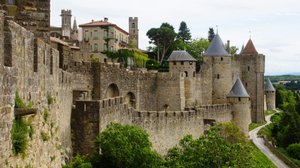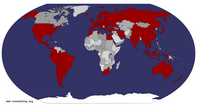Advertisement
Published: July 18th 2016

 La Cite
La Cite
The outer walls of La Cite.My insomnia/jet-lag struck again on my last night in Andorra and I only managed 3-4 hours sleep. I keep thinking that I'm gonna have to collapse at some point - this can't go on. Reversing my body clock is proving irritatingly difficult.
It's never great to be groggy on a travel day so luckily this time it was easy; I was about to embark on my first Bla Bla Car ride. As explained in
my last blog entry, the idea is brilliant - the driver makes a bit of money from a trip he/she was going to take anyway and the passenger saves a whole lot of dough. Plus, carpooling is great for the environment too.
And I have to say that my first two rides - from Andorra la Vella to Toulouse and then from Toulouse to Carcassonne - were unqualified successes. Both drivers were friendly and talkative, as were my fellow passengers. Both drivers had nice cars too, so both journeys were more than comfortable and the first journey even came with the stunning scenery of the Pyrenees.
And boy did I save some money too; if I had taken the bus from Andorra la Vella to Toulouse and then the
train to Carcassonne, I would've paid 53€! I can fly back to London from here for that. In total I paid 20€ for both rides - a cool saving of 33€, which is one day's budget.
I had been dreading the day that I would arrive back in France for a while - for the first time in almost a year, I would be in a country where Spanish is not widely spoken. I realised that now I could no longer ask the kind of slightly-more-than-simple questions that I've got used to asking. I was like any other clueless backpacker now, having now lost my smug advantage. In saying that, when reading and listening to French, I find I can understand more than I used to thanks to my Spanish. It was still frustrating not being able to speak though - it felt much like it did
when I was in Brazil last year. It didn't feel great, but I think I'd pick it up quite easily if I took some lessons - I just need to learn how to conjugate verbs and learn more vocabulary. Thanks to my sister, my pronunciation is pretty much down pat and the grammar is very similar to Spanish.

 City Walls By Night
City Walls By Night
La Cite's outer walls lit up at night.If going to
Havana was like stepping back in time to the 50s, then going to Carcassonne's
cite was like stepping into a medieval fairytale.
With this old-walled city perched on top of a hill, with entrance to the city by drawbridge, and with every building beautifully restored inside, this was on first impressions, a breathtaking fantasy brought to life.
I have to say that I've not stayed in many good hostels in France. The hosteling scene is dominated by Hostelling International and its network of hostels all over the country. These
auberge de jeunesses are what hostels started out as; large, institutionalised buildings designed for teenagers and large groups of school children with curfews, lockouts, a hospital-like atmosphere, push-button showers and a sterile atmosphere.
They seemed to have improved since
I last stayed in them; gone are the curfews and lockouts although the hospital-feel and sterility still remain. And they no longer seem to cater for youngsters but the total opposite these days - the majority of people here were old and middle-aged men. The place was deathly quiet too.
Then again, Carcassonne doesn't seem like the place for young backpackers to come and hang out. I've managed to avoid

 Haberdashery Storefront
Haberdashery Storefront
In the 'new' town outside the city walls.them through the places I've been visiting, which are slightly off the beaten European backpacker track; places such as
Bilbao and Andorra. I've already done most of the big cities and favoured European destinations such as
Amsterdam,
Budapest,
Berlin etc.
Now I was hitting the more unorthodox destinations.
In a fairytale town, I watched a fairytale football match on the telly - France winning the opening match of the European Championships they were hosting with a wonder goal in the last minute from Dmitri Payet, a player nowhere near the national team a year ago. The one thing that Euro 2016 will ensure during my time in France is that I will always have something to do on my evenings for the next month!
But Carcassonne really is a fairytale town; right from the drawbridge entrance of the Porte Narbonnaise, to the families with kids running around with small wooden swords.
La Cite - and I was lucky enough to be staying right inside it - really is a medieval dream brought to life with its beige bricks, cobblestone streets and snaking narrow alleys. Within what is seemingly this massive castle is the Basilique St Nazaire with its

 Basilique St Nazaire
Basilique St Nazaire
Main church inside La Cite.Gothic design (though once you've seen one medieval church, you've seen them all) and inevitably, lots of tourists. And with all the sweet and souvenir shops around, things take a tacky turn but luckily not too much, knowing that all the buildings around you are authentic and real.
Perched on a hilltop, walking the outer ramparts of La Cite does also provide you with some spectacular views across the new town of Carcassonne and the French countryside.
The tourist draw does push up prices though - prices in La Cite are about double what they are outside the city walls in the main town. My joy at seeing Wales win their first match of the tournament against Slovakia was tempered by the fact that I'd just paid 7€ for a pint of beer! Later on, when I watched England typically 'do an England' and contrive to draw a game they had completely dominated in the last minute against Russia, a pint was a mere 3€. So no more drinking in La Cite then!
But the town of Carcassonne outside La Cite is also quite pleasant. There is the old stone pedestrian bridge of Pont Neuf which does its best

 Chateau Comtal
Chateau Comtal
Palace where the rulers of the city resided.to imitate the
Charles Bridge in Prague and there are some lovely squares and cute alleyways in the main town too, even if they are incomparable in charm to the ones in La Cite. The buildings here too are old - I was expecting it to be more like a modern urban sprawl.
On my last day I checked out Carcassonne's showpiece - the Chateau Comtal.
Established by the Romans with rudimentary walls, the town passed into the possession of Viscount Raimond-Bernard Trencavel through the feudal system in place during the 11th century. It was then the Trencavel family who built the palace - the original version of the Chateau Comtal.
Such landlords like the Trencavels saw themselves above the rule of the Kingdom of France and pretty much ran the town affairs as they saw fit. Not that there was anything particularly wrong about the way things were being run in Carcassonne - it was just that Carcassonne became a stronghold of Catharism, an offshoot of Christianity denounced by the Catholic church. It was under the order of the Pope that Carcassonne was attacked by the French King Louis VIII's troops. Rather than die in a siege of the

 Alleys Of Carcassonne
Alleys Of Carcassonne
Typical medieval alley in La Cite.city, Viscount Raimond-Roger de Trencavel surrendered and 'offered' Carcassonne to the Kingdom of France. In return, he was imprisoned in his own palace dungeon until he died in mysterious circumstances.
The city then came under the control of Simon de Montfort and from there the city walls were continually reinforced against a constant stream of attackers and more and more towers were built until the town fell into decline at the end of the 18th century.
As well as the city walls, the palace itself was fortified to keep out the local townsfolk out who regularly rebelled. These townsfolk were eventually run out of the city and established themselves in the lower town which is now the modern-day main town of Carcassonne, which became prosperous through trade in textiles.
It wasn't until the discovery of a bishop's body in the Basilique St Nazaire did Carcassonne come to the attention of Eugene Viollet-le-Duc - the famous architect who restored the Cathedral Notre Dame in Paris amongst other famous historic buildings - who then set about restoring the church and then the rest of the
cite, over 50 years. It was during this restoration that the flat-tiled turrets were added to give

 Carcassonne By Night & Pont Vieux
Carcassonne By Night & Pont Vieux
La Cite lit up at night with the old bridge crossing the River Aude.Carcassonne its fantastical charm.
These days the palace acts as a museum of the area with artefacts from the palace itself and the town on display. It also guides you through the palace itself, giving you information on what was inside it back in its heyday. Your 8.50€ also got you access to the inner ramparts of the city, giving you yet more views over the lower town and the countryside.
I was reluctant to pay the 8.50€ at first - but given that I spent almost two hours exploring the place, I would say that it was just about worth it in the end, especially since I learnt a great deal about the place and the city.
Visually, Carcassonne is a photographer's paradise - but it is really no more than a day trip. With nothing but old people I couldn't relate to staying at the hostel, there wasn't really a lot of fun to be had here either. Not that there seemed to be any pumping nightlife anyway, either in La Cite or the lower town. Oh yeah, and my hayfever kicked off again here - it's what happens when you're in the open plains of Europe

 City Walls
City Walls
With those fantastical turrets.in June. So I needed to move on - next stop: the Cote d'Azur and Marseille!
A la prochaine,
Derek
Advertisement
Tot: 0.174s; Tpl: 0.014s; cc: 32; qc: 35; dbt: 0.0882s; 1; m:domysql w:travelblog (10.17.0.13); sld: 1;
; mem: 1.3mb
























Dancing Dave
David Hooper
Palaces & Castles
Fantastic additions to the Palaces & Castles thread in the Photography Forum. Love 'em Derek!